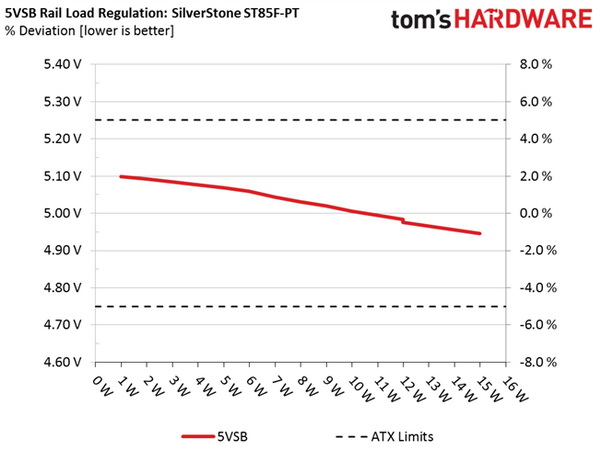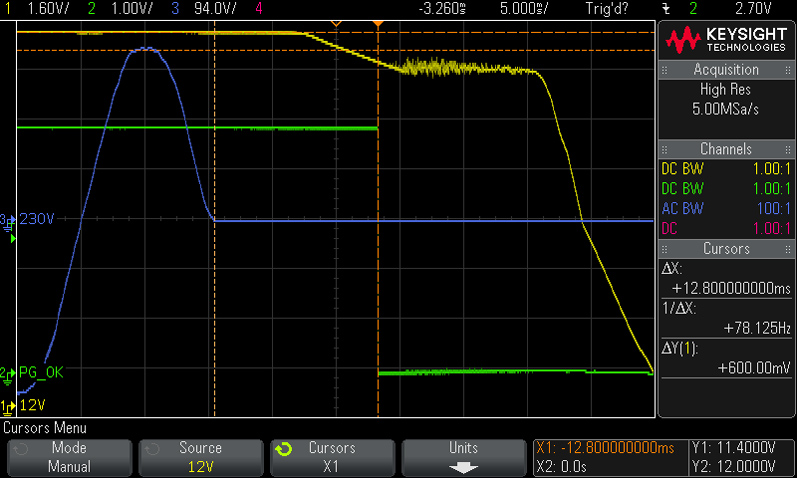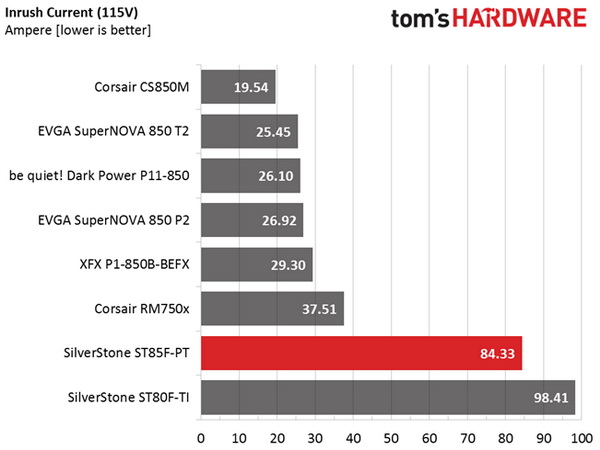SilverStone Strider Platinum ST85F-PT PSU Review
SilverStone's Strider Platinum series offers compact dimensions along with Platinum efficiency and a fully modular cable design. The 850W member of this line will be evaluated today. Its strong card against the competition is the 471W power density score.
Why you can trust Tom's Hardware
Load Regulation, Hold-Up Time, And Inrush Current
To learn more about our PSU tests and methodology, please check out How We Test Power Supply Units.
Primary Rails And 5VSB Load Regulation
Load Regulation testing is detailed here.








Hold-Up Time
Our hold-up time tests are described in detail here.







The hold-up time is much lower than the ATX spec's allowed minimum, and to make matters worse the power-good signal lasts longer than the hold-up time, meaning it drops when the rails are already out of spec.
Inrush Current
For details on our inrush current testing, please click here.


The lack of an NTC thermistor inevitably leads to high inrush currents.
Load Regulation And Efficiency Measurements
The first set of tests reveals the stability of the voltage rails and the PSU's efficiency. The applied load equals (approximately) 10 to 110 percent of the maximum load the supply can handle, in increments of 10 percentage points.
Get Tom's Hardware's best news and in-depth reviews, straight to your inbox.
We conducted two additional tests. During the first, we stressed the two minor rails (5V and 3.3V) with a high load, while the load at +12V was only 0.1 A. This test reveals whether a PSU is Haswell-ready or not. In the second test, we determined the maximum load the +12V rail could handle with minimal load on the minor rails.
| Test # | 12V | 5V | 3.3V | 5VSB | DC/AC (Watts) | Efficiency | Fan Speed | Fan Noise | Temps (In/Out) | PF/AC Volts |
|---|---|---|---|---|---|---|---|---|---|---|
| 1 | 5.158A | 1.964A | 1.961A | 0.986A | 84.79 | 89.51% | 0 RPM | 0 dB(A) | 49.34 °C | 0.975 |
| 12.252V | 5.093V | 3.361V | 5.069V | 94.73 | 38.90 °C | 115.1V | ||||
| 2 | 11.340A | 2.946A | 2.950A | 1.185A | 169.64 | 91.97% | 0 RPM | 0 dB(A) | 49.76 °C | 0.988 |
| 12.238V | 5.083V | 3.353V | 5.059V | 184.45 | 39.15 °C | 115.1V | ||||
| 3 | 17.896A | 3.448A | 3.468A | 1.385A | 254.78 | 92.21% | 1235 RPM | 36.8 dB(A) | 39.46 °C | 0.995 |
| 12.221V | 5.073V | 3.343V | 5.044V | 276.31 | 42.20 °C | 115.1V | ||||
| 4 | 24.466A | 3.946A | 3.956A | 1.588A | 339.72 | 92.17% | 1350 RPM | 38.9 dB(A) | 40.24 °C | 0.996 |
| 12.203V | 5.064V | 3.334V | 5.031V | 368.60 | 43.26 °C | 115.1V | ||||
| 5 | 30.707A | 4.948A | 4.962A | 1.791A | 424.63 | 91.81% | 1450 RPM | 37.6 dB(A) | 41.66 °C | 0.997 |
| 12.184V | 5.055V | 3.323V | 5.020V | 462.49 | 44.89 °C | 115.1V | ||||
| 6 | 36.980A | 5.944A | 5.973A | 1.995A | 509.58 | 91.30% | 1525 RPM | 38.7 dB(A) | 42.79 °C | 0.997 |
| 12.164V | 5.043V | 3.314V | 5.006V | 558.17 | 46.28 °C | 115.1V | ||||
| 7 | 43.262A | 6.959A | 6.988A | 2.200A | 594.51 | 90.66% | 1565 RPM | 41.1 dB(A) | 43.86 °C | 0.998 |
| 12.145V | 5.032V | 3.304V | 4.995V | 655.73 | 47.80 °C | 115.1V | ||||
| 8 | 49.573A | 7.965A | 8.014A | 2.404A | 679.44 | 89.87% | 1580 RPM | 41.9 dB(A) | 44.39 °C | 0.998 |
| 12.125V | 5.021V | 3.294V | 4.983V | 756.04 | 48.78 °C | 115.1V | ||||
| 9 | 56.330A | 8.482A | 8.552A | 2.410A | 764.41 | 88.78% | 1580 RPM | 41.9 dB(A) | 45.59 °C | 0.998 |
| 12.104V | 5.012V | 3.285V | 4.975V | 861.03 | 50.46 °C | 115.1V | ||||
| 10 | 62.831A | 9.005A | 9.070A | 3.030A | 849.17 | 88.10% | 1590 RPM | 42.0 dB(A) | 45.77 °C | 0.998 |
| 12.087V | 5.002V | 3.275V | 4.945V | 963.85 | 50.92 °C | 115.1V | ||||
| 11 | 69.973A | 9.026A | 9.092A | 3.035A | 934.01 | 86.96% | 1590 RPM | 42.0 dB(A) | 46.32 °C | 0.998 |
| 12.066V | 4.990V | 3.266V | 4.937V | 1074.11 | 51.88 °C | 115.1V | ||||
| CL1 | 0.099A | 14.024A | 14.005A | 0.000A | 119.03 | 84.14% | 0 RPM | 0 dB(A) | 55.61 °C | 0.987 |
| 12.240V | 5.062V | 3.344V | 5.152V | 141.46 | 45.15 °C | 115.1V | ||||
| CL2 | 70.782A | 1.003A | 1.003A | 1.001A | 868.73 | 88.40% | 1590 RPM | 42.0 dB(A) | 44.68 °C | 0.998 |
| 12.085V | 5.019V | 3.289V | 4.991V | 982.69 | 49.36 °C | 115.1V |
Load regulation isn't particularly tight compared to the other offerings in this category. As for efficiency, it is much higher with 20% load than required. With 50% load it is very close to 92%, and under full load it falls within 1% of the minimum threshold. We'll give the ST85F-PT a pass since we conduct our tests at very high ambient temperatures.
The unit's fan is deactivated during our first two load tests, keeping the acoustic reading at zero. The fan starts spinning quickly during the third load test, which we'd expect given its 120 mm diameter. Fortunately, the noise isn't bad. Even in a worst-case scenario the ST85F-PT doesn't exceed 42 dB(A). This is the major benefit of using a low-speed fan.
Current page: Load Regulation, Hold-Up Time, And Inrush Current
Prev Page A Look Inside And Component Analysis Next Page Efficiency, Temperature And Noise
Aris Mpitziopoulos is a contributing editor at Tom's Hardware, covering PSUs.
-
panathas I don't understand, first you said: "On the other hand, it doesn't have an issue with inaccurate power-good signals that last longer than the corresponding hold-up time" and your last words were: "It is a great shame though that it is affected by the inaccurate power good signal disease". Which one is true? Also in the CONS section you only mentioned the Hold-up time and not the power good signal.Reply -
turkey3_scratch Reply18699506 said:I don't understand, first you said: "On the other hand, it doesn't have an issue with inaccurate power-good signals that last longer than the corresponding hold-up time" and your last words were: "It is a great shame though that it is affected by the inaccurate power good signal disease". Which one is true? Also in the CONS section you only mentioned the Hold-up time and not the power good signal.
First one must have been an mistake since it does drop the PWR_OK after the voltages are already out of spec. -
Aris_Mp Yes something was way out in this phrase. It is fixed now.Reply
This PSU is affected by a fake power good signal, which usually is the case in Sirfa's platform.
In the cons section. Sometimes I don't mention the fake power good signal, when the hold-up time is already too low. But I will make sure that I do from now on. -
Virtual_Singularity ty for the review. So, I know it's kind of not really adequate for comparison considering the watt difference. But, looking at the performance of that last Lian Li sfx reviewed, and this thing, still must say that LL didn't do so badly, though they could really help things if they extended that warranty by at least a year or more.Reply -
Co BIY I think the exterior photos need something for scale. Full-size black boxes and tiny high efficiency black boxes look the same size on a screen without something for scale.Reply
No comment on vacant modular socket plugs. First time I've seen that. Also the copper bars aren't a feature I've seen commented on before.


